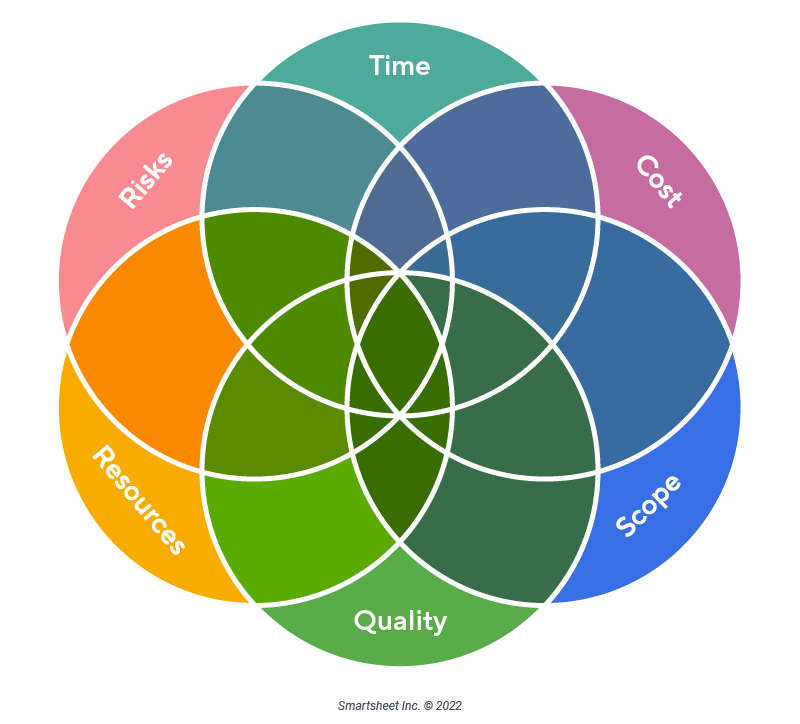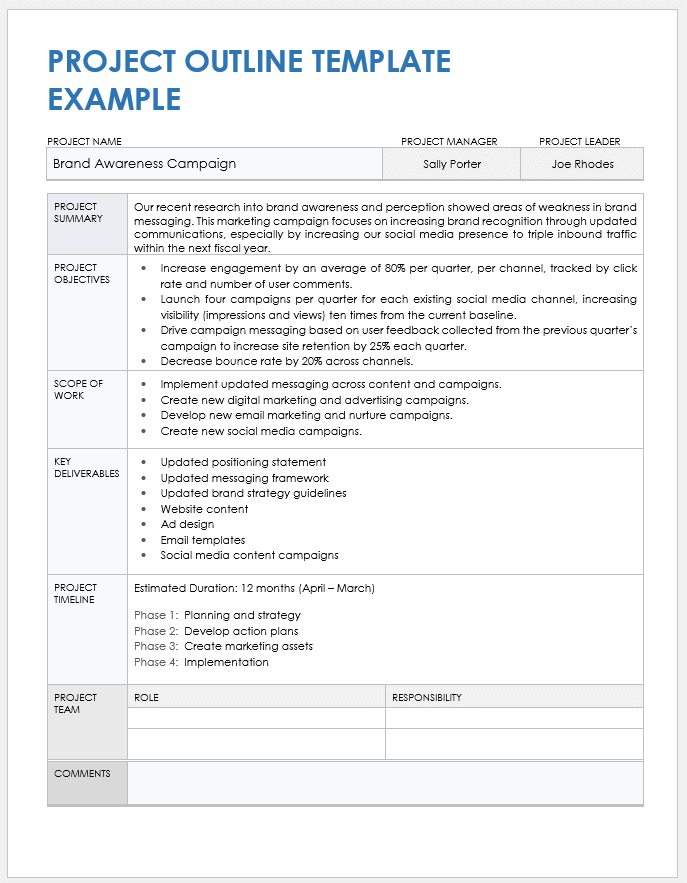What Is a Project Outline?
A project outline is a foundational document in project management. Project managers create the outline to formally define the project. A project outline includes project goals, objectives, necessary resources, and timeline. Once approved, it becomes the blueprint for future documents.
Like a project overview, the project outline is a central part of project planning. It connects the project’s goals and objectives to larger business goals. The designated project leader writes this approximately two-page document as a high-level overview of the project vision and the work necessary to accomplish it. The project overview is also called a project charter or project definition document (PDD).
Eric Verzuh, President and Founder of The Versatile Company, stresses the importance of a project outline: “Writing the outline is arguably the most important thing you do on a project. It’s probably the first time someone has put the project down in writing. It takes all the gray out or at least figures out what the project actually is.”
“It’s the starting point for one of the top five project success factors: agreement on the goal,” Verzuh continues. “It answers, ‘Why are we doing this, what do we mean when we do this, and what do we expect when we’re done?’ This is the key moment to resolve any disagreements rather than spend money and make mistakes.”
In addition to agreeing on a goal, the project outline should address each of the top five project success factors noted in Verzuh’s book, The Fast Forward MBA in Project Management.
Here are the success factors Verzuh describes and how the outline accomplishes each:
| Success Factor | Outline Contribution |
|---|---|
| 1. Agreement on the Goal | The outline answers the following questions to align the team:
|
| 2. Having a Plan | The outline is the basis for delegating responsibilities. |
| 3. Clear Communication Between All Stakeholders | The outline is the first time formal communication occurs. |
| 4. Scope Management | The outline is the first attempt at establishing the scope. |
| 5. Management Support | The outline is the first step to securing support from management. |
An assigned project owner (typically the project manager or project sponsor) formally defines the project during the project initiation phase. This phase is the first of five in the project management lifecycle, in which the project owner completes the outline and presents it to management for approval.
Once approved, the outline becomes the basis for the next phase’s project planning documents. Throughout the project, the team frequently references the outline to ensure that their actions align with the initial goals.
It is important to note that the project outline is not to be confused with a project proposal, which is a business case for why the project is necessary. An outline communicates how the work will be done, whereas a proposal communicates why.
Who Should Create a Project Outline?
A project sponsor or project manager should create the project outline. The person responsible for leading the project is also responsible for the outline, regardless of their title. This project owner involves stakeholders and team members to assemble the document.
Joe Heagney, President of QMA International, LLC and author of Fundamentals of Project Management, points out that "the information populating the project outline/charter is often provided by the project sponsor or another senior person within the organization, but the project manager should try to get involved as soon as possible. Remember, it is your project."
If you are assigned as the project owner, it is crucial for you to write an outline, even if it is not required. Verzuh shares, “You may not always be asked to write one, but you always should if you’re leading a project. It shows that you understand what you’re being asked to do and is best practice for clarifying the assignment.”
As the sponsor or manager assembles the document, they’ll involve project members as needed. These may include team members, clients, or stakeholders. The outline then helps to create a shared understanding between all project contributors and decreases miscommunication during stakeholder management activities.
Project Outline Components
The components of a project outline inform the reader of key project information. This information includes project scope, background, timeline, team members, resource requirements, and more. These items provide context and clarify any ambiguities prior to project execution.
Here are the components of a project outline:
- General Information: This section includes basic information, such as the project name, project sponsor, project manager, and creation date.
- Project Summary: The project summary is a concise overview of the project that briefs the reader on the project’s context.
- Background: This includes all pertinent information supporting each project activity. Background information can be a separate section or be used throughout the document to help the reader understand why you included certain factors in the outline.
- Project Scope: A project scope is a detailed list of what the project entails and the methods needed to deliver the work. The scope also outlines the project boundaries or what it does not include.
- Objectives: Objectives are measurable statements specifying how the project will meet its goals and how the team will know the goals have been met.
- Constraints and Assumptions: Constraints are any known project limitations. These might relate to budget, quality, or other factors. Assumptions, on the other hand, are factors believed to be true by the team.
- Key Stakeholders: Include a detailed list of the internal and external stakeholders involved in the project, as well as their roles and responsibilities.
- Key Team Members: Include a list of team members, each of their roles, and their responsibilities.
- Deliverables: Include deliverables, or a brief description of the project’s inputs, outputs, and ancillary results, such as reports.
- Project Timeline: The project timeline should include the start date, end date, and significant milestones.
- Resource Requirements: Include any resource requirements, or a list of the activities and components necessary to complete the deliverables.
- Comments: This section includes any project notes or action items that will help the team understand the document or clarify details about the project.
- Budget: This final section is optional. Include initial budget information if it is available.
Verzuh also recommends including potential risks, even at a basic level: “Risk is always worth pointing out. Significant risks are always worthwhile because it tends to influence a lot of individual things and the overall project.”
How to Write a Project Outline
Writing a solid project outline takes thought, communication, and planning. As you write it, your primary activity will be to collect and assemble information that defines the project. Make time to gather feedback and revise the document before submitting it.
Before you get started, create a timeline and completion checklist to keep yourself on track. While the time it takes to write the outline varies per project, plan enough time to collect information, populate the document, and review it before the submission date.
You can use an existing project outline template to get started or create your own from scratch. Follow the steps in the order we’ve listed below, or do them in the order that makes the most sense for your project. For any step, be sure to get feedback and contributions from team members.
Here is a step-by-step guide to writing your project outline:
- Add Basic Information: Start by filling in the project title, basic information, author, and version date at the top.
- Identify Key Stakeholders and Team Members: Determine and recruit the best possible members for the team, and record their names, roles, and responsibilities. You may need to ask for recommendations from trusted colleagues. List all team members, sponsors, stakeholders, clients, and customers who will at some point be affected by the project. Confirm with each team member that they understand their role.
For team members and stakeholders, Verzuh shares that it’s helpful to include information about the “time team members will spend (for example, if they’re on the project part-time) and, in addition to key stakeholders, helpful information such as who’s paying and who’s the executive sponsor, specific clients, or internal customers.” - Summarize the Project: Write a brief overview that helps the reader understand the project and how it creates business value. The summary can be as short as two or three sentences.
Verzuh reminds us that “projects are meant to deliver business value. The PM’s job is to keep an eye on business value and keep all stakeholders moving toward business value. The project summary is important because it creates the context.” - Articulate Project Goals: Take time to specify the aims of the project. What does it need to deliver? Why does it need to deliver it? How will this project achieve that goal? Write the goal succinctly, and include any background rationale for the project decisions. Keep the goal at a high level, and make sure it connects to the overall business goals.
Example: Increase our social media presence in order to triple inbound website traffic within the next fiscal year. - Determine Project Objectives: First, brainstorm objectives based on the goal. Write down what the project will improve, reduce, remove, or optimize. Then write down how your team will make these improvements and how they will measure their success. While SMART goals are a common framework, Verzuh recommends using it as a guide, rather than adhering exactly to the framework. Here are some sample objectives, based on the previous goal:
- Example 1: We will launch four campaigns per quarter for each existing social media channel, increasing impressions and views by a factor of 10.
- Example 2: Our engagement will increase an average of 80 percent per quarter, per channel, tracked by click rate and number of user comments.
- Example 3: We will drive campaign messaging based on user feedback collected from the previous quarter’s campaign in order to increase site retention by 25 percent each quarter and decrease bounce rate by 20 percent.
Pro Tip: Verzuh says, “Think of the project summary and project objectives as the North Star to return to and ask, ‘Are we still on track with these?’”
- Define the Scope and Deliverables: According to Verzuh, “Scope and deliverables go hand in hand. The scope is written as a verb. The deliverable is the noun that results.” Clarify what scope of work is within the project boundaries and what is outside. It is especially important to detail what is out of scope.
- List Required Resources: Provide a broad overview of any required resources, including people, facilities, costs, equipment, time, or information. You don’t need to get too detailed during this step. Once the project is approved, you’ll expand on your initial estimation. Cite any supporting background information, such as historical data or comparisons to previous projects, as evidence.
- Draft a Project Timeline: Select a project start date and an estimated completion date. Then add the major milestones between the two dates. “Put whatever milestone you know about, and put your background for how you came up with that timeframe,” says Verzuh. “For example, if your timeline states that the planning and strategy need to be done by X date, include how you came up with that number.”
Consider using Verzuh’s questions as prompts:- What if we don’t get it done by the decided date?
- Will that be a problem if we go past the date? Is there a penalty for missing it?
- Is there a business reason for having it done by that time?
- How does it sync up with your purpose statement?
- Identify Project Constraints and Assumptions: Consider all constraints within which the project needs to be accomplished. Use the six constraints as you consider what factors might impact your project.
- Next, list the assumptions, or what your team believes to be true. For example, what do you expect to rely on or hold to be true about time, staff, resources, costs, or equipment?
In this section, also consider and include any significant risks that will impact or interfere with the project’s success. - Note the Costs: You do not need a detailed budget, but it is helpful to include costs. Verzuh suggests writing “something basic so that it’s acknowledged, such as ‘We expect to spend X amount on personnel.’”
- Get Feedback: If you haven’t already, ask team members and stakeholders to review the document or pertinent sections. Be receptive to their perspective, and be open to making changes.
- Review and Revise: Read through the document, and modify any language that is unclear. Make final revisions based on your review and the feedback from the previous step. Take your revisions back to team members to get input on the adjustments. Repeat until you have crafted a high-quality document.
- Present the Outline: If you are required to present the outline, enter the meeting prepared with a presentation deck. Practice discussing the project outline with colleagues. Anticipate any questions that might occur during the presentation.
Project Outline Sample Template
Download a Sample Project Outline Template for
Microsoft Word
|
Adobe PDF
| Google Docs
Download a Blank Project Outline Template for
Microsoft Word
|
Adobe PDF
| Google Docs
Use this project outline sample template to help you articulate your project goals and align your team to them. Download the one-page sample template to see an example of how to write a high-level project overview, project summary, objectives, scope, and key deliverables. Then use the blank template to create your own project outline.
Tips for Writing a Project Outline
We’ve rounded up expert tips to help you write a great project outline. Use these tips to keep your document focused and effective. A successful outline will help align stakeholders and team members to the project goals.
Here are our top tips for writing a project outline:
- Use a Template: Start with a template. You can create your own or use a pre-existing project outline template.
- Stay Organized: Keep the document well-structured.
- Don’t Rush: Set aside enough time to create a quality outline.
- Identify Conflicts: Act as a detective who is finding out where stakeholders disagree. Verzuh says, “We always know there's a disagreement; we don’t know what it is until we discover it. This is a great time to discover those problems.”
- Get Feedback: Be open to feedback, and be ready for revisions.
- Be Persuasive: Write for the reader with the goal of getting everyone on board. Keep in mind that the outline could be the first critical gate of the project, as the project's approval most likely relies on the document. Verzuh says, “Devise your project outline to address the key things that need to be said about the project. Particularly for internal work, this could be the basis for deciding whether to move forward on a project.”
- Remember Your Audience: Read all completed sections with your audience in mind. Make sure the content clearly answers what each group or person needs to know. View the process as a means to shed light on the project. Heagney says, “The process of creating the outline is one of clarification. The project manager must engage with stakeholders, identify their wants and needs, then begin constructing requirements.”
- Edit and Revise: Cross-check your work by having team members from multiple areas review it. By doing so, they might discover information gaps or sections that are unclear.
- Keep It Simple: Simple is best. After reading your outline, flag sections that didn’t make sense and rewrite them. If you don’t easily understand it, your reader won’t either. Use formatting, such as bullets, to your advantage.
- Use Quantifiable Data: When writing requirements, Heagney recommends making sure they “are measurable and verifiable.”
- Acknowledge Constraints: Be realistic when determining the triple constraint (scope, schedule, and cost). Verzuh recommends asking yourself, “Are there any threats within the project environment that would prevent you from meeting the schedule, goals, or project objectives, or cause it to be much more expensive than anticipated?”
- Acknowledge Risks: Don’t make decisions based on the perfect execution of the project. Assume that at least 20 percent of the project will encounter challenges.
Benefits of Writing a Project Outline
The benefits of writing a project outline make it worth taking the time to create one. Doing so supports your project’s success, avoids costly miscommunication, and empowers your team. Ultimately, it eases your job as a project manager.
Here are the benefits of writing a project outline:
- Better Team Alignment: By clearly stating goals and objectives, the outline aligns all team members to the project goals.
- Clearer Communication: Establish unambiguous communication from the outset with a project outline.
- Clearer Roles: The project outline clarifies roles and responsibilities from the start.
- Fewer Disagreements: By aligning team members from the outset, project outlines help resolve disagreements before they become costly.
- Improved Stakeholder Relations: Keeping stakeholders apprised of project goals means you are better able to manage stakeholder expectations and relations.
- Improved Time Management: Help the team manage time by including a timeline and schedule in your outline.
- More Helpful Milestones: Create success points within the project with milestones.
- Optimized Workflow: By clarifying team roles and responsibilities in the project outline, you help foster efficient workflows.
- Reduced Scope Creep: Defining your project’s scope in the outline helps avoid or mitigate scope creep.
Additionally, Verzuh notes that creating a project outline “builds your own expert authority, demonstrates you’re the person who’s competent and organized to lead the project, establishes the document as an authority over stakeholders as a touchpoint to remind them of the agreement, and serves as the first project success factor.”
Optimize Your Project Outlines with Real-Time Work Management in Smartsheet
Empower your people to go above and beyond with a flexible platform designed to match the needs of your team — and adapt as those needs change.
The Smartsheet platform makes it easy to plan, capture, manage, and report on work from anywhere, helping your team be more effective and get more done. Report on key metrics and get real-time visibility into work as it happens with roll-up reports, dashboards, and automated workflows built to keep your team connected and informed.
When teams have clarity into the work getting done, there’s no telling how much more they can accomplish in the same amount of time. Try Smartsheet for free, today.



